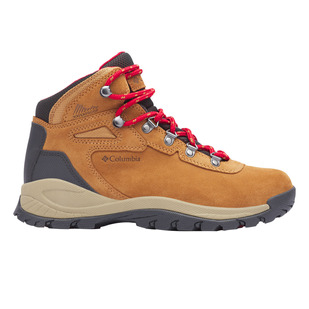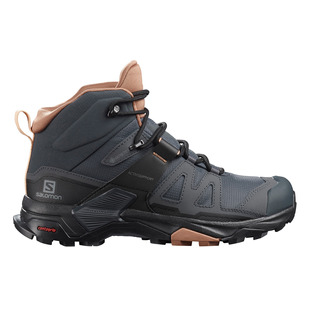BUYING
Outdoor shoes are designed for those times when you’re off on a short hike lasting from a few hours to a maximum of two days on relatively easy, flat terrain, with just an average amount of gear on your back.
Although this type of style often features full-grain leather construction, nubuck, synthetic leather and nylon can also be used to make the shoe lighter in weight and increase breathability. In fact, a growing number of manufacturers are producing outdoor shoes that combine materials: leather at strategic points for durability, and nylon in the appropriate places for ventilation. Certain styles in this category also incorporate breathable membranes.
The sole of an outdoor shoe should be stiff enough to ensure a stable footing and help prevent sprains. However, it should also have a certain amount of flexibility, especially if you’ll only be tackling flat terrain. Finally, the outsole should feature lugs which have sufficient grip to ensure good traction but are also spaced out enough for any mud or earth that could get stuck in between them to clear out on its own.
Shoe construction
In general, shoes comprise a number of parts. The first is the upper, which refers to everything above the sole. The upper includes the vamp, which forms the top of the shoe, from the toe to the instep (in line with the lower part of the ankle); the toe box, which, as its name suggests, covers the toe area; the tongue, an extension of the vamp (or located beneath it) protecting the front of the foot; and the collar (or cuff), which provides a kind of seal to prevent anything from getting inside the shoe. Finally, the back of a shoe is made up of a heel seatjoining the quarters, the two rear sides of the upper, which sometimes incorporates a counter, a kind of reinforced support that keeps the heel firmly in place and minimizes the risk of spraining an ankle.
For its part, the sole is made up of three layers: the outsole, which comes into direct contact with the ground; the insole (or footbed) that the foot rests on; and the midsole, which is sandwiched between the previous two and absorbs shocks. The midsole is sometimes topped by ashank reinforcement of varying length for extra rigidity. A removable sock liner (or comfort sole) is often put inside the shoe, while a lininghugs the foot to ensure comfort and support.
Shoe materials
Of course, leather—flexible, hard-wearing, breathable, relatively water-resistant and able to be waterproofed, is the material most commonly used in making shoes. Full-grain leather is particularly sturdy, but more expensive. Leather that comes from a thinner part of an animal hide will be more affordable, but less durable.
Suede is created by sanding the interior side of a hide. It is more flexible and breathable, but also less hard-wearing. Another type of finishing process involving sanding can transform leather into nubuck, which gives it the look of deerskin.
Leather is also often used for shoe linings, since it is comfortable and takes on the shape of the foot more quickly. However, it will then make the shoe heavier
Resembling the real thing at first glance and nearly waterproof, synthetic leather nonetheless does not wear as well, is less breathable, and tends to crack with too much exposure to the sun. In all other respects, however, it shares practically the same properties as leather, and costs less.
Used in extreme hiking or mountaineering boots, plastic is just as waterproof as it is rigid. It is sometimes also used to fashion certain shoe components, such as toe boxes and shanks.
A number of synthetic fabrics frequently go into the making of shoes and boots because of their light weight, low cost or relative breathability. Polyester or nylon is generally used for vamps or linings, while polyester is most often preferred for the inside of a shoe. However, there are a few exceptions in which leather is used instead, particularly in the case of hiking boots.
A recent generation of designs features varying-sized areas of nylon or polyester mesh to ventilate uppers.
In the opposite vein, rubber stands out for its waterproofness, but this advantage has its downside—imperviousness, which keeps heat and moisture in. On the other hand, it is very practical for making certain parts of an upper and, in particular, a hard sole.
The insides of shoes sometimes incorporate breathable membranes to help wick moisture away. Similar membranes are occasionally combined with mesh so that the shoe both breathes and remains waterproof.
Finally, midsoles may be made of polyurethane, which is relatively heavy, or Evazote (EVA), if the design aims for comfort and durability. For their part, carbon or fibreglass are often used to lend more rigidity to a shank.
USE
Before being able to get full use of your new outdoor shoes, it’s sometimes necessary to have to break them in by first wearing them in a different situation than the one for which they were designed, so that they will take on the shape of your feet. This will enable you to avoid ending up with blisters—or very sore feet—the first time you put them on to go out on a serious expedition. The best method for breaking them in is to wear them at home for a while, being sure to climb some stairs and try out some of the moves you know you’ll be making in the great outdoors.
Ideally, in order to keep them in good condition for as long as possible, leather styles should be given a protective treatment and/or waterproofed before being worn and exposed to bad weather. Certain types of seams should also be sealed with a specialized product in order to ensure that the shoe will be completely waterproof.
To avoid blisters when you’re out on the trail, make sure that your socks fit well and are made of quick-drying materials like synthetic fibres or merino wool. You can also wear a very thin synthetic-fibre liner sock under the regular pair, which will help prevent skin from rubbing against the inside of the shoe. Finally, you can sprinkle talcum powder on your feet before pulling on liner socks and socks to maximize the chances of them staying dry. If, despite all these precautions, you do end up with a blister, cover the skin with a bandage or moleskin (double-layered flannel padding).
If it’s been a hard day and you go back to your camp site with a pair of dirty shoes, wash them with water, if possible, and then let them dry in the open air and away from the sun, to prevent UV rays from affecting the uppers. Also make sure shoes aren’t put too close to campfires, wood stoves or other similar sources of heat, which is sometimes much stronger than you would think and which can result in irreversible damage to shoes.













